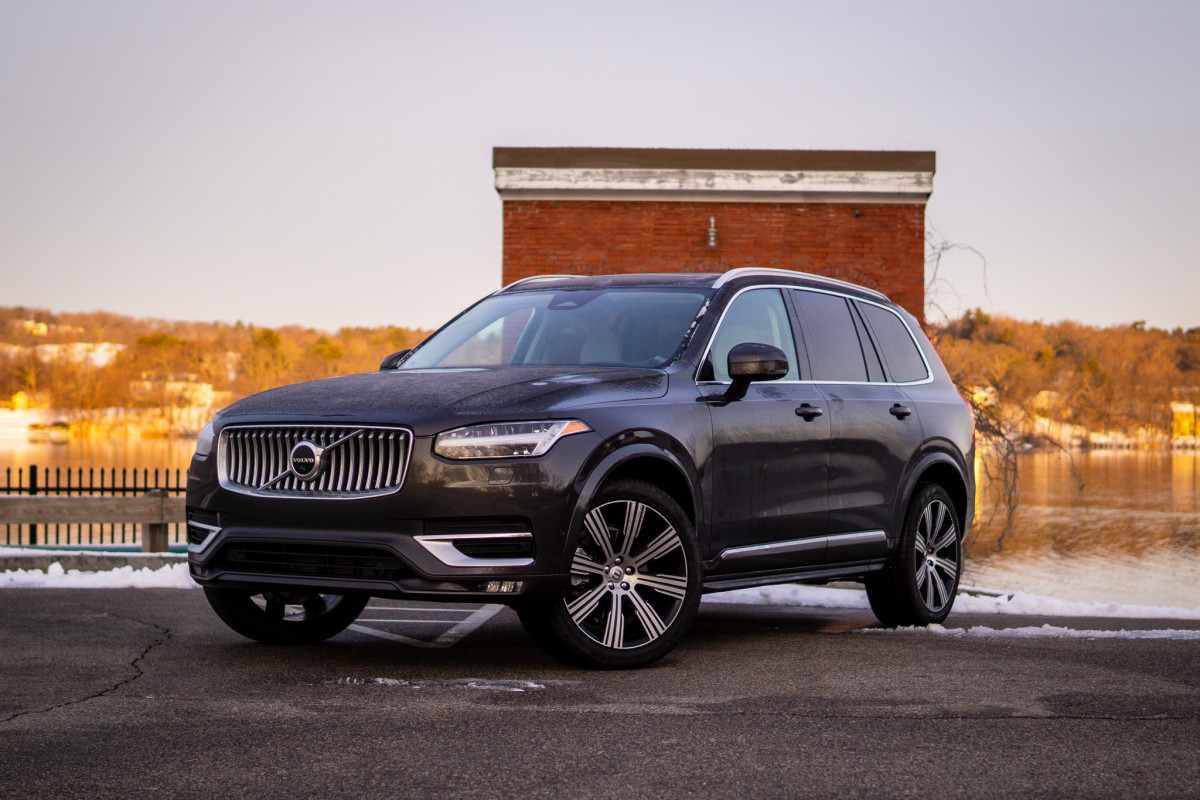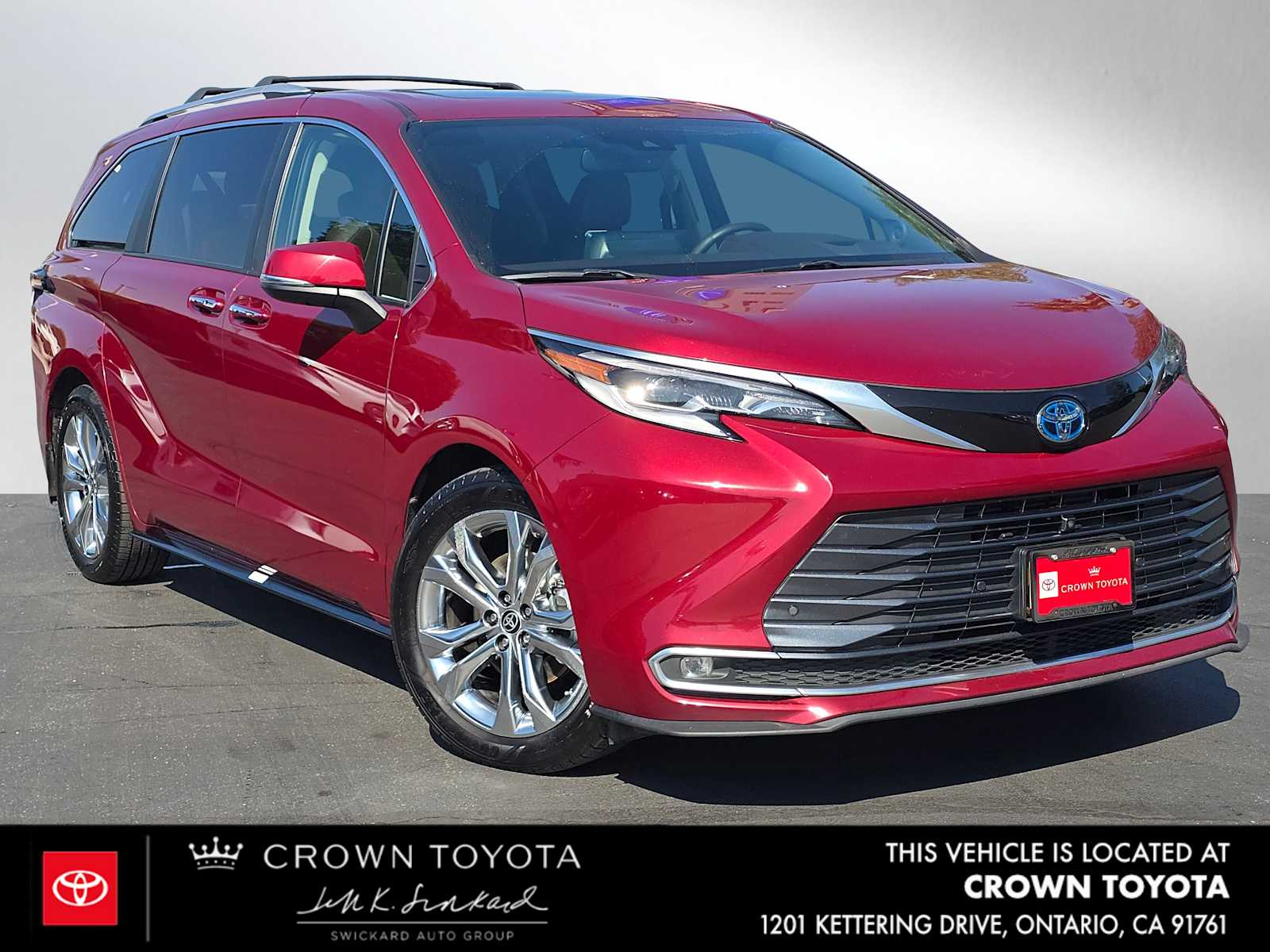2022 Toyota Sienna vs 2023 Volvo XC90
Overview | |
MSRP$35,285 | MSRP$56,000 |
Listings588 | Listings1026 |
Ratings & Reviews | |
User Reviews | User Reviews |
Expert reviews8.7 out of 10 | Expert reviews8.0 out of 10 |
Pros
Cons
| Pros
Cons
|
2022 Toyota Sienna Reviews SummaryThe 2022 Toyota Sienna hybrid minivan rolls into the second model year following a redesign for 2021. Last year’s successful makeover with a standard hybrid powertrain returns unchanged, but a new Woodland trim level is available to attract adventurous families (or those who want to look that way). | |
2023 Volvo XC90 Reviews SummaryIn sophisticated circles, the XC90 can feel like an old friend. Its design has evolved subtly over the past twenty years, making it recognizable without looking old. For 2023, the XC90’s powertrains have evolved, too. Out with the T5 and T6 engines, in with the B5 and B6 mild-hybrid powertrains. Finally, Google lovers will absolutely want to investigate the new XC90’s forward-thinking infotainment technology. | |
No video found | |
Popular Features & Specs | |
Engine2.5L 245 hp I4 Hybrid | Engine2.0L 247 hp I4 |
Drive TrainFWD | Drive TrainAWD |
Seating Capacity8 | Seating Capacity7 |
Horsepower | Horsepower247 hp @ 5500 rpm |
EV Battery Capacity1.9 kWh | EV Battery Capacity |
MPG City36 | MPG City22 |
MPG Highway36 | MPG Highway28 |
Engine | |
Engine Name2.5L 245 hp I4 Hybrid | Engine Name2.0L 247 hp I4 |
Torque | Torque258 lb-ft @ 1500 rpm |
Horsepower | Horsepower247 hp @ 5500 rpm |
DrivetrainFWD | DrivetrainAWD |
Fuel Economy | |
EV Battery Capacity1.9 kWh | EV Battery Capacity |
MPG City36 | MPG City22 |
MPG Highway36 | MPG Highway28 |
Interior | |
Seating Capacity8 | Seating Capacity7 |
Key Features | |
Navigation System | Navigation SystemStandard |
Sunroof/Moonroof | Sunroof/MoonroofStandard |
Safety | |
Front Crash Overall4 | Front Crash Overall5 |
Side Crash Overall5 | Side Crash Overall5 |
Dimensions & Capacity | |
Cargo Space33.5 cu ft | Cargo Space10.7 cu ft |
Curb Weight4610 lbs | Curb Weight4589 lbs |
Height68.5 in | Height69.9 in |
Length203.7 in | Length195.0 in |
Width78.5 in | Width84.3 in |
Wheelbase120.5 in | Wheelbase117.5 in |
Maximum Payload1560 lbs | Maximum Payload1210 lbs |
Number of doors4 | Number of doors4 |
Maximum Towing Capacity3500 lbs | Maximum Towing Capacity5000 lbs |
Overview | ||
MSRP | $35,285 | $56,000 |
Listings | ||
Ratings & Reviews | ||
User reviews | ||
Expert reviews | 8.7 out of 10Read full review | 8.0 out of 10Read full review |
Pros & cons | Pros
Cons
| Pros
Cons
|
Summary | The 2022 Toyota Sienna hybrid minivan rolls into the second model year following a redesign for 2021. Last year’s successful makeover with a standard hybrid powertrain returns unchanged, but a new Woodland trim level is available to attract adventurous families (or those who want to look that way). | In sophisticated circles, the XC90 can feel like an old friend. Its design has evolved subtly over the past twenty years, making it recognizable without looking old. For 2023, the XC90’s powertrains have evolved, too. Out with the T5 and T6 engines, in with the B5 and B6 mild-hybrid powertrains. Finally, Google lovers will absolutely want to investigate the new XC90’s forward-thinking infotainment technology. |
Video | No video found | |
Popular Features & Specs | ||
Engine | 2.5L 245 hp I4 Hybrid | 2.0L 247 hp I4 |
Drive Train | FWD | AWD |
Seating Capacity | 8 | 7 |
Horsepower | 247 hp @ 5500 rpm | |
EV Battery Capacity | 1.9 kWh | |
MPG City | 36 | 22 |
MPG Highway | 36 | 28 |
Engine | ||
Engine Name | 2.5L 245 hp I4 Hybrid | 2.0L 247 hp I4 |
Torque | 258 lb-ft @ 1500 rpm | |
Horsepower | 247 hp @ 5500 rpm | |
Drivetrain | FWD | AWD |
Fuel Economy | ||
EV Battery Capacity | 1.9 kWh | |
MPG City | 36 | 22 |
MPG Highway | 36 | 28 |
Interior | ||
Seating Capacity | 8 | 7 |
Key Features | ||
Navigation System | Standard | |
Sunroof/Moonroof | Standard | |
Safety | ||
Front Crash Overall | 4 | 5 |
Side Crash Overall | 5 | 5 |
Dimensions & Capacity | ||
Cargo Space | 33.5 cu ft | 10.7 cu ft |
Curb Weight | 4610 lbs | 4589 lbs |
Height | 68.5 in | 69.9 in |
Length | 203.7 in | 195.0 in |
Width | 78.5 in | 84.3 in |
Wheelbase | 120.5 in | 117.5 in |
Maximum Payload | 1560 lbs | 1210 lbs |
Number of doors | 4 | 4 |
Maximum Towing Capacity | 3500 lbs | 5000 lbs |
The 2022 Toyota Sienna occupied a unique position in the automotive market. Minivans were often unjustly pushed aside by the rising popularity of SUVs, but Toyota never shied away from this class of vehicles. With a lineage dating back to the 1984 Toyota Van and its innovative successors like the mid-engined Previa, the Sienna firmly established itself in 1998. The fourth-generation Sienna, which arrived in 2021 and carried over into 2022, didn't shy away from its minivan identity but incorporated SUV-like styling cues to stay relevant.
The Sienna’s exterior design was assertive, with Toyota going the extra mile to re-engineer door hinges and sliding mechanics to make it look less like a traditional minivan. Featuring a macho front end and seamlessly integrated rear door channels, the Sienna had a solid stance. Wheel options ranged from standard 17-inch alloys to larger 18- and 20-inch variants on upper trims, enhancing its street presence.
Inside, the Sienna offered an uncluttered design, focusing heavily on practicality. The spacious interior provided ample storage, including innovative areas like under-console storage. With seating for up to eight passengers, the minivan featured comfortable second-row captain’s chairs with ottomans and a spacious third-row bench capable of conveniently folding into the floor. The Sienna avoided the school-bus vibe despite its functionality, making it a pleasant environment for families.
Volvo made significant strides in vehicle design since the days of the boxy 240DL and 700 series. The 2023 XC90 exemplified this transformation with its sleek yet purposeful appearance. The front end was stout and solid without being overly flashy, and its assertive grille and signature Thor’s Hammer headlights brought a modern flair that stands out.
Our AWD Ultimate test model featured 21-inch wheels that filled the wheel wells nicely, adding a touch of drama to the otherwise tasteful exterior. The Platinum Gray paint, with subtle brown undertones, varied in richness depending on the lighting, making the XC90 an understated yet attractive choice.
Inside, the XC90 exuded Scandinavian elegance. Highlights included two-tone leather on the steering wheel, classy wood inlays, and luxuries like an Orrefors crystal shift knob and Nappa leather upholstery. Despite its minimalist and clean design, the XC90 suffered a bit from insufficient cubby space for personal items.
















The Sienna, continuing from its 2021 model, featured an exclusive hybrid powertrain—a noteworthy inclusion, given Toyota's history in producing hybrids. It utilized a 2.5-liter four-cylinder engine paired with two electric motors, generating 243 horsepower. Buyers had the choice of FWD or AWD, the latter incorporating an additional electric motor driving the rear wheels with 54 hp and 89 lb-ft of torque.
The Sienna boasted an electronically controlled CVT, offering smooth power delivery, and four selectable drive modes: Normal, EV, Eco, and Sport. Its handling was surprisingly agile for a minivan, largely due to its TNGA platform, which included a well-tuned front suspension and independent rear trailing arm suspension.
Fuel efficiency was the Sienna’s highlight, with the EPA clocking 36 mpg city, highway, and combined for FWD models, and slightly lower ratings for the AWD variants.
Volvo retired the previously turbocharged T5 and turbo-and-supercharged T6 engines in favor of the new mild-hybrid B5 and B6 setups. The B5, a turbocharged 2.0-liter four-cylinder, produced 247 horsepower and 258 lb-ft of torque. The B6 added a supercharger to the mix, delivering 295 horsepower and 310 lb-ft of torque.
Mild-hybrid technology distinguished these powertrains from full hybrids. Rather than driving the car exclusively on electric power, the 48-volt mild-hybrid system powered auxiliary functions, smoothing out the start-stop system and aiding in fuel efficiency. However, these models didn’t achieve the high fuel economy of full hybrids.
Despite its bulky dimensions, the XC90 handled corners well due to its lower body roll, and the eight-speed automatic transmission delivered smooth and responsive shifts. The driving experience was quiet and composed, with commendable road and wind noise insulation. Its braking system provided a solid, confidence-inspiring pedal feel, essential for a luxury SUV.
The Sienna proved to be a family workhorse capable of carrying a 4x8 sheet of plywood with the tailgate closed. Its sliding second-row seats added considerable flexibility for both passengers and cargo. Standard cargo measurements were 33.5 cubic feet behind the third-row seats, 75.2 cubic feet behind the second row, and a substantial 101 cubic feet with all rear seats folded. Additionally, the Sienna could tow up to 3,500 pounds.
Every row offered ample cupholders and storage spaces, making it highly practical for families. Power-operated side sliding doors and a rear tailgate added convenience, particularly when approaching the vehicle with arms full.
The XC90 excelled in front-seat comfort but fell short in practical storage solutions. The second-row seats offered reasonable space but were tricky to adjust. The standard layout included a seven-passenger configuration, but choosing six-passenger seating with captain’s chairs required additional costs and an engine upgrade.
Accessing the third row was challenging, and once back there, space was limited. Cargo capacity was competitive with 12.5 cubic feet behind the third row, 41.8 cubic feet with the third row folded, and 65.5 cubic feet with all rear seats down. Although decent, these figures lagged behind competitors like the Infiniti QX60 and Acura MDX.
The Sienna came loaded with standard tech features, including a 9-inch touchscreen, Apple CarPlay, Android Auto, and Amazon Alexa, alongside multiple USB ports. However, it lacked wireless Apple CarPlay and Android Auto, a noticeable omission.
Higher trims offered advanced multimedia systems, from a six-speaker audio setup to a 12-speaker JBL system, along with optional rear-seat entertainment. Drivers could benefit from a 10-inch head-up display and a digital rearview mirror in higher trims, enhancing safety and convenience.
Volvo's XC90 featured an advanced infotainment system running Google OS, integrating Google Maps, Google Assistant, and more. Despite its smart design and intuitive voice control, many functions were buried in the touchscreen, which could be frustrating for some.
While natural language recognition was excellent, the reliance on the touchscreen for functions like seat adjustments and climate control detracted from the user experience. Drivers and passengers needed to spend time getting used to this system.
The 2022 Sienna received stellar safety ratings, including a Top Safety Pick+ from the IIHS and five stars from the NHTSA. Standard safety features under Toyota Safety Sense 2.0 included adaptive cruise control, lane departure warning, automatic emergency braking, and more.
Additionally, the Sienna had 10 airbags, multiple LATCH connectors, and a rear-seat reminder system. This focus on safety made it a compelling choice for families.
Volvo, known for its safety heritage, delivered with the 2023 XC90. It matched the Sienna’s five-star NHTSA rating and Top Safety Pick+ from the IIHS. Standard safety tech included adaptive cruise control, lane-keeping assist, and Pilot Assist for semi-autonomous driving.
Volvo’s long-standing emphasis on safety made the XC90 a trustworthy vehicle, particularly for those driving in busy or challenging conditions.
CarGurus highlights

According to CarGurus experts, the overall rating for the 2022 Toyota Sienna is 8.7 out of 10, while the 2023 Volvo XC90 scores 8.0 out of 10. Based on these ratings, we recommend the 2022 Toyota Sienna for its superior practicality, cutting-edge hybrid technology, and exceptional safety features, making it the more well-rounded choice between these two vehicles.
Choose the 2022 Toyota Sienna if:
- You need a highly practical family vehicle with vast cargo space.
- You prioritize fuel efficiency with hybrid technology.
- You value a suite of advanced safety features for peace of mind.
Choose the 2023 Volvo XC90 if:
- You appreciate luxurious and elegant interior design.
- You want an advanced infotainment system with seamless Google integration.
- You prioritize a well-established reputation for safety and driving comfort.
CarGurus highlights

According to CarGurus experts, the overall rating for the 2022 Toyota Sienna is 8.7 out of 10, while the 2023 Volvo XC90 scores 8.0 out of 10. Based on these ratings, we recommend the 2022 Toyota Sienna for its superior practicality, cutting-edge hybrid technology, and exceptional safety features, making it the more well-rounded choice between these two vehicles.
Choose the 2022 Toyota Sienna if:
Shop Now- You need a highly practical family vehicle with vast cargo space.
- You prioritize fuel efficiency with hybrid technology.
- You value a suite of advanced safety features for peace of mind.
Choose the 2023 Volvo XC90 if:
Shop Now- You appreciate luxurious and elegant interior design.
- You want an advanced infotainment system with seamless Google integration.
- You prioritize a well-established reputation for safety and driving comfort.

By: CarGurus + AI
At CarGurus, our team of experienced automotive writers remain at the heart of our content operation, conducting hands-on car tests and writing insightful guides that are backed by years of industry experience. To complement this, we are harnessing AI to make our content offering more diverse and more helpful to shoppers than ever. To achieve this, our AI systems are based exclusively on CarGurus content, ratings and data, so that what we produce is both unique to CarGurus, and uniquely helpful to car shoppers.



































